Ziemlich viel Bewegung gab es zuletzt beim FC St. Pauli auf der Torwart-Position. Robin Himmelmann und Svend Brodersen haben nach langen Jahren den Verein verlassen. Dejan Stojanović ist nach einem halben Jahr schon wieder weg. Mit Nikola Vasilj hat der FCSP eine neue Nummer 1, während sich Dennis Smarsch mit der Rolle des Pokal-Torhüters begnügen muss. Wie sind diese Entscheidungen zu bewerten? Wir haben nachgefragt bei jemandem, der sich mit dem Torwartspiel auskennt.
(Titelbild: Peter Böhmer)
Der erste Eindruck, den Nikola Vasilj beim FC St. Pauli hinterlassen hat, ist ziemlich gut: Drei Spiele, nur zwei Gegentore, sieben Punkte. Aber wie groß ist sein Anteil an diesem guten Saisonstart? Ich habe ehrlich gesagt vom Torwartspiel nicht wirklich viel Ahnung. Entsprechend tue ich mich bei der Bewertung von Torhütern immer schwer und habe mir daher kompetente Hilfe geholt. Sascha Felter hat dem MillernTon im Interview einen kurzen Überblick zur Bewertung von Torhütern und der Veränderungen des Torwartspiels gegeben. Und natürlich hat er auch eine Einschätzung zur Torwart-Situation beim FCSP geliefert.
Zur Person:
Sascha Felter schreibt als Torwart-Experte für die 11Freunde und Cavanis Friseur, einem Fußballblog, der sich vor allem mit dem Spielerscouting befasst. Felter war lange selbst Torhüter und ist jetzt Torwart-Trainer bei Rotation Leipzig (dem Jugendverein von Marco Rose). Da es in den Medien wenige bis gar keine Expert*innen für das Torwartspiel gibt, hat er sich vor einiger Zeit selbst daran gemacht und analysiert u.a. auf Twitter die Leistungen verschiedener Torhüter sehr viel detaillierter und kompetenter als es alle anderen tun.
Sascha, Du bist Torwart-Experte. Kannst Du kurz erklären, wie sich das Torwartspiel in den letzten zehn Jahren verändert hat?
Sascha Felter: Bei der WM 2014 gab es ja mit Manuel Neuer eine Art zusätzlichen Feldspieler, der die Räume in der Verteidigung im Alleingang abgelaufen ist. Da gab es in den letzten Jahren einige Keeper, die diesem Trend gefolgt sind. Das sind zum Beispiel Stefan Ortega von Arminia Bielefeld oder Marc-Andre ter Stegen bei Barcelona. Der Trend ging in den letzten Jahren eindeutig dahin, dass viele versucht haben den Raum aktiver zu verteidigen. Das versuchen auch Torhüter von denen man das nicht unbedingt erwarten würde. Péter Gulácsi von Leipzig zum Beispiel, der den Raum ziemlich gut kontrolliert und oft ziemlich unterschätzt wird.
Der noch größere Trend ist, dass Torhüter mittlerweile die Spielgestalter von hinten heraus sind. Da geht es weniger darum, dass sie präzise lange Bälle von hinten herausspielen, sondern eher darum, dass sie trotz Druck den Ball sauber hinten raus spielen können, z.B. mit gechippten Bällen auf die Außenverteidiger oder bestenfalls auf die Sechser, damit ein sauberer Spielfluss bestehen kann. Das ist sicher der größte Trend den es aktuell gibt, sodass sich sogar Keeper, denen das Phlegma des „Linientigers“ anhaftet, dahin entwickelt haben, dass sie ein Spiel super eröffnen können. Koen Casteels zum Beispiel wird auch oft unterschätzt, spielt aber super Bälle hinten raus.
Mindestens so wichtig wie Bälle halten: Strafraumbeherrschung
Viele tun sich schwer damit Torhüter richtig zu bewerten. Was sind denn die wichtigsten Skills von Torhütern?
SF: Das kann man nicht so richtig an Zahlen ausmachen, wie es bei Feldspielern möglich ist, wo zum Beispiel die gewonnenen Zweikämpfe zumindest einen Trend vorgeben. Bei Torhütern ist das nicht ganz so leicht. Es gibt mittlerweile den „post-shot-xG“ – Wert, mit dem man vergleichen kann wie viele Tore ein Torhüter im Vergleich zu den xG-Werten verhindert hat. Damit sind leichte Trends zu erkennen, aber es ist auch nicht des Rätsels Lösung.
Für mich ist immer ganz wichtig wie ein Torwart sich verhält, wenn Schüsse auf sein Tor kommen. Nimmt er vorher schon eine gute Position ein? Hat er eine ruhige Position oder hampelt er rum? Timo Horn ist da ein gutes Beispiel. Der zieht seine Ellenbogen nach hinten, wenn ein Schuss kommt. Du brauchst deine Hände aber vor dem Körper, wenn Du Bälle halten willst. Es ist ganz wichtig, dass es immer eine gute Vorbereitung auf Torschüsse gibt. Torhüter brauchen auch einen guten Stand am Boden und dürfen nicht rumspringen, wenn der Schuss abgegeben wird, denn sie müssen sich zeitnah vom Boden aus abdrücken, um in die Aktion reinzukommen. Das sind wichtige Aspekte, wenn es um die Zielverteidigung, um Schüsse auf das Tor geht.
Im Spiel mit Ball ist es wichtig, dass Torhüter einen guten ersten Kontakt haben. Sie müssen auch wissen, wie sie den Ball in welche Richtung annehmen müssen, um sich aus dem Druck des gegnerischen Stürmers zu entfernen. Besonders technisch starke Torhüter zeichnet ein guter erster Kontakt und eine gute Vororientierung und auch taktisches Verständnis aus. Alle weiteren Aktionen sind dann eher die Sahne auf der Kirsche, wenn da mit der Hacke oder dem Außenrist gearbeitet wird.
Würdest Du daher empfehlen, dass Klubs sich je nach taktischer Ausrichtung bestimmte Torhüter ins Team holen?
SF: Ja klar, wenn Du wie Arminia Bielefeld vermehrt auf lange Bälle setzt, dann brauchst Du einen Torwart wie Ortega, der lange Bälle spielen kann und damit zur Team-Taktik beiträgt. Wenn Du hingegen wie zum Beispiel Atletico Madrid den Gegner meistens kommen lässt und auf Konter spielst, dann brauchst Du einen Keeper, der vor allem auf der Linie gut ist. Da braucht es weniger Keeper wie Neuer oder Ortega, die häufig aus dem Strafraum stürmen und Bälle abfangen.
Grundsätzlich brauchen besonders Teams, die unten drin stehen einen Keeper mit einer sehr guten Strafraumbeherrschung. Torschüsse werden solche Teams auch gegen sich bekommen, aber der Großteil sind Steckpässe in die Tiefe, lose Bälle im Strafraum, Flanken – wenn ein Team da einen Keeper hat, der präsent ist im Strafraum, dann nützt es ungemein. Es nützt sogar noch viel mehr als ein Torhüter, der Großchancen vereitelt, weil Keeper mit guter Strafraumbeherrschung viele Chancen vorher vereiteln. Als Klub musst Du da natürlich schauen, welcher Keeper Dir mit seinen Skills am meisten nützt, aber die meisten Klubs gehen so nicht im Scouting vor.
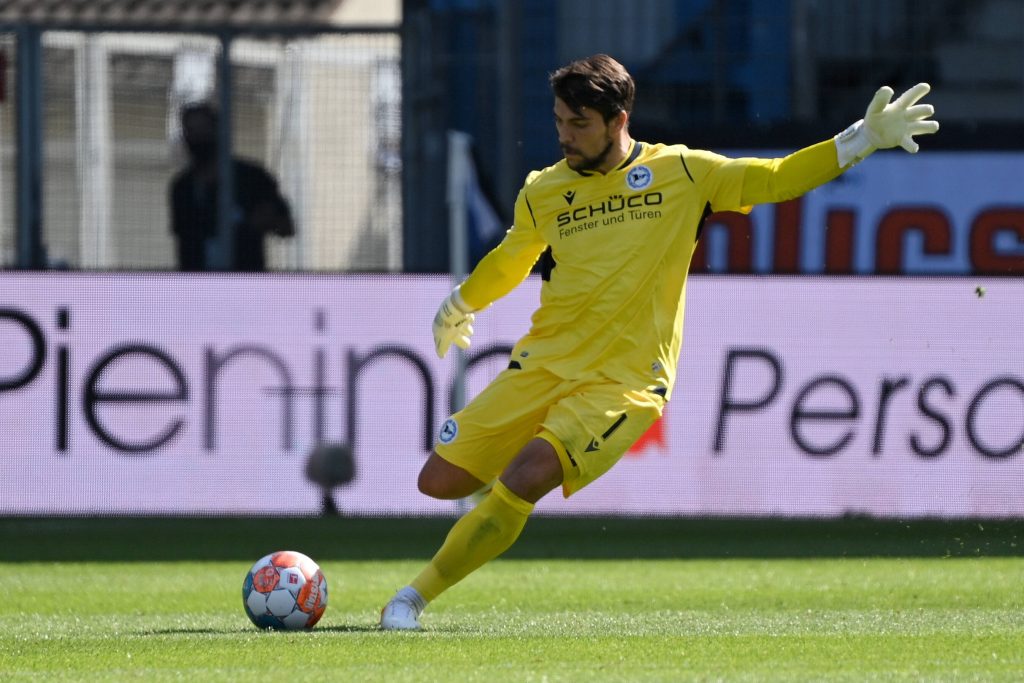
(imago images/via OneFootball)
Strafraumbeherrschung ist ein gutes Stichwort. Für mich ist das einer der Begriffe, mit dem Sportjournalist*innen dealen, aber meist gar nicht zuordnen können, ob Torhüter eine gute Strafraumbeherrschung haben oder nicht. Wie kann man sowas einschätzen? Die Anzahl an abgefangenen Bällen reicht vermutlich nicht aus, oder?
SF: Zum Teil schon, doch. Aber auch da muss man schauen, wie die Flanken zustande gekommen sind. Man muss schauen, wie viele Flanken in den Strafraum kommen und wie oft der Torhüter sich auszeichnen konnte. Dazu muss man sich auch die Körpergröße der Torhüter anschauen. Ein Negativ-Beispiel ist Jiri Pavlenka von Werder Bremen, der trotz seiner 1,96m kaum Bälle abgefangen hat in den letzten Jahren. Da lag seine Quote bei 5%. Eine sehr gute Quote in der Bundesliga ist etwa bei 8 bis 10%.
Für mich ist auch wichtig wie aktiv ein Keeper bei Flanken und langen Bällen ist. In Sachen Strafraumbeherrschung bin ich übrigens sehr von Robin Zentner von Mainz 05 überzeugt. Wenn ein Torhüter im offenen Spiel bereits sieht, dass der Ball z.B. aus dem Halbfeld heraus reingeschlagen wird, kann er passiv am Fünfmeterraum stehen oder aktiv versuchen den Ball an der Strafraumgrenze abzufangen. Es ist auch immer wichtig zu sehen, wie sich die Keeper bei Flanken positionieren. Wenn bei Flanken z.B. der Ball vom Tor weg geschlagen wird, dann sollte ein Torhüter immer etwas näher am langen Pfosten stehen. Denn dem Ball entgegen gehen, kann er immer noch. Das Zurücklaufen, wenn die Flanke länger wird, ist immer schwieriger.
Sascha, wer war in der letzten Saison der beste Keeper Europas?
SF: Also wenn ich jetzt den Namen Stefan Ortega hier droppen würde, dann wäre es vermutlich ein bisschen zu viel des Guten. Ich würde auf jeden Fall Thibaut Courtois von Real Madrid herausstellen. Jan Oblak von Atletico Madrid würde ich bei dieser Bewertung ein wenig ausklammern, da er in Sachen Spielaufbau nicht so sehr eingebunden wird wie seine Kollegen, obwohl er taktisch und technisch herausragend ist. In der Bundesliga würde ich noch Péter Gulácsi und Koen Casteels hervorheben, weil das sehr grundsolide Keeper sind, die kaum Schwächen haben, ohne wie z.B. Manuel Neuer ein herausstechendes Merkmal zu haben. Alisson Becker von Liverpool hat mir letzte Saison nicht so gut gefallen. Aber Emiliano Martínez von Aston Villa ist sicher dazu zu zählen. Der hat auch ne ziemlich krasse Karriere hinter sich, wurde jahrelang von Arsenal immer nur verliehen und hat sich, ähnlich wie Leon Goretzka, in der Corona-Pause ziemlich aufgepumpt und Bernd Leno danach im Arsenal-Tor vertreten. Also Ortega, Casteels und Martínez, das ist ein schönes Trio, oder?
Keine spektakulären Flugeinlagen? – Ein Qualitätsmerkmal
Ja, das klingt ziemlich gut. Ich stelle trotzdem die Gegenthese auf: Betrachtet man nur die Save rate zusammen mit den verhinderten xG, dann ist es Nikola Vasilj, die neue Nummer 1 des FC St. Pauli, der letzte Saison im europäischen Vergleich herausragte. Wie bewertest Du ihn als Torhüter?
SF: Ich würde ihn tatsächlich in eine ähnliche Kategorie stecken wie Gulásci und Casteels. Nikola Vasilj ist ein Keeper, der sein Handwerk absolut versteht, der klar seine Stärken in der Strafraumbeherrschung hat und einen sehr soliden Eindruck macht. Ich kann da bei ihm, Stand jetzt, kaum Schwächen erkennen. Er wirkt sehr sicher in seinen Abläufen, ist immer sehr früh fertig und früh in Position, fuchtelt auch nicht mit den Händen groß herum. Dadurch kann er oft auch unspektakuläre Paraden zeigen, was aus meiner Sicht ein Qualitätsmerkmal ist. Denn wenn Du einen Keeper hast, der im Tor häufig spektakulär rumfliegt und noch drei Rollen macht nach der Parade, dann ist das meist ein Zeichen dafür, dass die Vorbereitung auf den Torschuss nicht optimal war. Daher würde ich schon sagen, dass die Verpflichtung von Nikola Vasilj ein sehr guter Transfer für den FC St. Pauli gewesen ist.
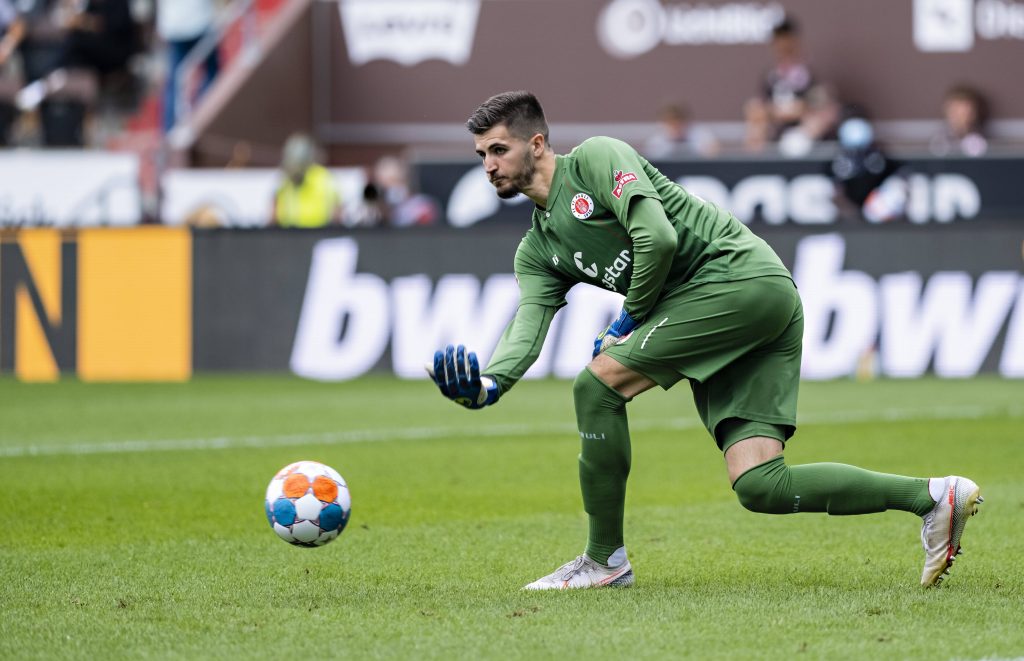
(imago images/via OneFootball)
Spielmacher-Skills würde ich bei ihm aber nicht ausmachen…
SF: Fand ich jetzt auch nicht so herausragend, da würde ich mit dir übereinstimmen. Aber wenn dein Keeper mittellange und lange Bälle beherrscht und einen guten ersten Kontakt hat, dann ist das auch völlig okay. In der 2.Liga wird ja auch nicht so viel Champagner-Fußball gespielt.
Wo siehst Du ihn im Vergleich zu den anderen Torhütern der 2.Liga?
SF: Ich sehe ihn zusammen mit Michael Zetterer und Daniel Heuer Fernandes in den Top3 der Liga. Sein Skillset gefällt mir gut und ich habe auch keine Bedenken, dass er im Saisonverlauf einbrechen wird. Beim Auftakt gegen Kiel hat er mir richtig gut gefallen, weil er sehr präsent im Strafraum war, viele Bälle abfing und viele Chancen des Gegners bereits im Keim ersticken konnte. Auch wenn er den Ball dann hatte, hat er in den richtigen Momenten auch mal das Tempo rausgenommen oder aber auch das Spiel schnell gemacht. Das wirkt alles schon sehr, sehr rund.
Zum Start der letzten Saison war Robin Himmelmann noch die Nr. 1 beim FC St. Pauli. Kannst Du Vasilj und Himmelmann vergleichen?
SF: Robin Himmelmann hat mir in 1-gegen-1 – Situation immer ganz gut gefallen. Er hatte da ein gutes Gefühl, wann er rausgehen muss und wann nicht, zeigte da selten ein schlechtes Timing. Er hat ein gutes Verständnis dafür gehabt, wie der Winkel zum Schützen sein muss. Und er hat auch gut entschieden, welche Verteidigungsart die beste ist, also ob er mit der Hand hingehen muss oder ob er einen Spreizschritt, einen sogenannten großen Block, macht oder nur das Knie runtermacht, also einen kleinen Block macht.
Allerdings gibt es de facto gar nicht so viele 1-gegen-1 – Situationen in einem Spiel im Vergleich zu den raumverteidigenden Aktionen, bei denen du Bälle abfangen und dein Tor verlassen musst. Und wenn dann das 1-gegen-1 deine Stärke ist, dann ist das zwar schön, aber wenn Du das andere nicht beherrscht, dann bist Du einfach kein kompletter Keeper. Ich glaub bei der WM 2018 gab es eine Statistik von der FIFA, die zeigte, dass knapp 70% der defensiven Torwartaktionen die raumverteidigenden Aktionen sind und nur knapp 30% die Zielverteidigung, also das Halten von Torschüssen, und von diesen 30% sind dann noch viel weniger 1-gegen-1 – Situationen. Daher ist für mich die Raumverteidigung sehr viel wichtiger anzusehen. Wenn Du da einen guten Keeper hast, dann hilft dir das als Team enorm weiter.
Robin Himmelmann – (k)ein kompletter Keeper?
Das finde ich besonders spannend. Denn meist ist es ja die Zielverteidigung, die von Zuschauer*innen zur Bewertung genutzt wird.
SF: Ja, das ist ein großes Problem. Daher kannst Du Keeper auch nur schwer anhand von Highlight-Videos bewerten. Sportschau- oder Sportstudio-Zuschauer*innen können eigentlich gar nicht wirklich was zur Leistungsfähigkeit von Torhütern sagen, weil sie nur Highlights sehen. Da müssen schon ganze Spiele geschaut werden, um das besser einschätzen zu können.
Beim FC St. Pauli ist Dennis Smarsch die Nr.2 bzw. der Pokal-Torhüter. Vor seinem Wechsel wurde er bei Hertha BSC als zukünftige Nr.1 gehandelt. Wie siehst Du seine Entwicklung?
SF: Es hat mich sehr gewundert, dass Hertha ihn so früh abgegeben hat.
Ich glaube die haben eine Rückkauf-Option…
SF: Würde mich auch wundern, wenn nicht. Smarsch ist ein sehr großes Talent in Deutschland und aus meiner Sicht zusammen mit Nico Mantl einer der besten Nachwuchskeeper. Aber er ist jetzt 22 Jahre alt und braucht zeitnah Spielpraxis. Es ist gut, dass er mit Vasilj jetzt jemanden vor sich hat von dem er viel lernen kann, aber in dem Alter sollte er zügig mindestens vierte Liga spielen. Es reicht nicht, wenn junge Torhüter nur neben erfahrenen Torhüter trainieren. Gerade der Unterschied zwischen Junioren- und Herren-Fußball, den kannst Du dir eigentlich nur in Pflichtspielen aneignen.
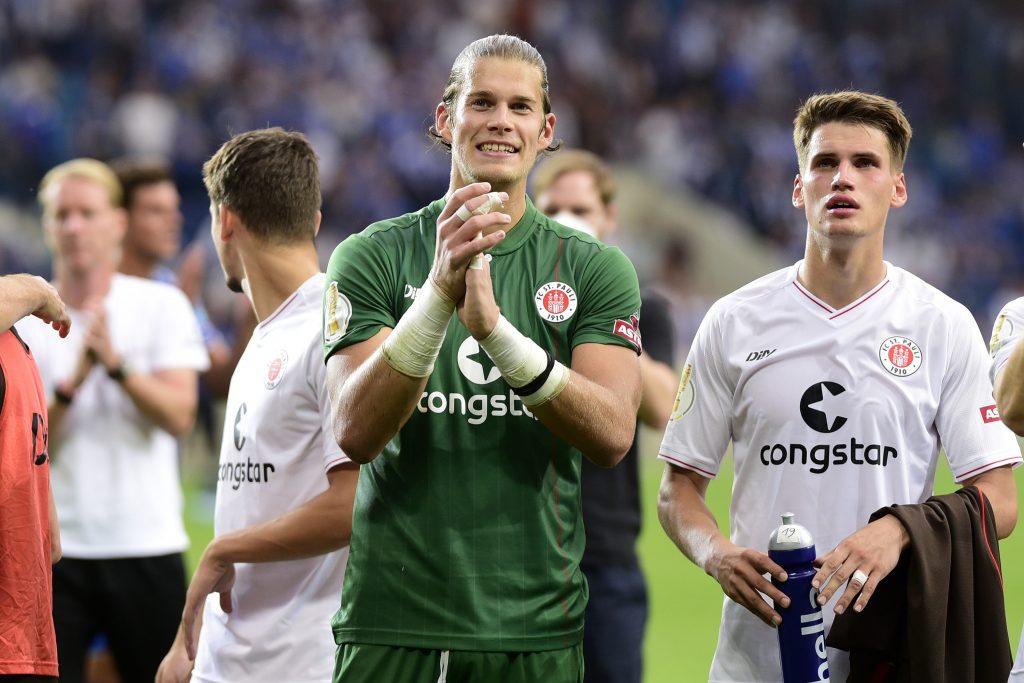
(c) Peter Böhmer
Der FC St. Pauli hat aktuell keinen dritten Torwart im Lizenzspieler-Kader. Würdest Du so eine Position überhaupt besetzen, wenn es in der U23 ebenfalls mehrere Keeper gibt und, wie Du sagst, junge Keeper so viel Spielzeit wie möglich sammeln sollten?
SF: Ich persönlich würde als Kaderplaner eine klare Nr. 1 benennen und dazu noch einen erfahrenen Torhüter im Kader haben wollen. Denn mal angenommen der FCSP verpflichtet Marius Liesegang, der im Probetraining war und ebenfalls wenig Erfahrung hat, und Vasilj verletzt sich: Dann hast Du zwei junge Keeper ohne wirkliche Profi-Erfahrung im Kader, bei denen Du gar nicht weißt, ob die im Herren-Fußball die Leistung abrufen können. Denn, wie gesagt, der Unterschied zwischen Junioren- und Herren-Bereich ist schon enorm. Entsprechend würde ich dem FC St. Pauli raten noch einen erfahrenen Keeper zu verpflichten, diesen auf die Bank zu setzen und Dennis Smarsch in der U23 spielen lassen.
Vielen Dank für deine Einschätzung, Sascha!
Das Torwartspiel hat sich verändert. Waren es früher vor allem das Können auf der Linie, sind es heute Themen wie Strafraumbeherrschung, aber auch Spielmacher-Fähigkeiten, die ein Keeper mitbringen muss. Mit der Verpflichtung von Nikola Vasilj scheint der FC St. Pauli einen Top-Transfer getätigt zu haben. Fraglich ist, wie es hinter Vasilj weitergehen wird. Idealerweise sammeln Torhüter, denen langfristig eine tragende Rolle zugetraut wird, möglichst viel Spielpraxis, z.B. in der U23. Die bisher unbesetzte Position des dritten Torwarts im Kader des FC St. Pauli könnte an einen erfahrenen Torwart gehen. Da ist also noch einiges unsicher beim FCSP. Sicher ist hingegen, dass ich nach diesem Interview das Torwartspiel ganz anders betrachten werde.
// Tim
Alle Beiträge beim MillernTon sind gratis. Wir freuen uns aber sehr, wenn Du uns unterstützt.
MillernTon auf BlueSky // Mastodon // Facebook // Instagram // Threads // WhatsApp // YouTube
{:}{:en}There has been quite a lot of movement at the goalkeeper position at FC St. Pauli recently. Robin Himmelmann and Svend Brodersen have left the club after many years. Dejan Stojanović has already left after half a year. With Nikola Vasilj, FCSP has a new number 1, while Dennis Smarsch has to be content with the role of cup goalkeeper. How should these decisions be assessed? We asked someone who knows a lot about goalkeeping.(Cover picture: Peter Böhmer)
The first impression Nikola Vasilj has made at FC St. Pauli is pretty good: three games, only two goals conceded, seven points. But how big is his part in this good start to the season? To be honest, I don’t really know much about goalkeeping. Accordingly, I always have a hard time evaluating goalkeepers and have therefore sought competent help. In an interview, Sascha Felter gave MillernTon a brief overview of the evaluation of goalkeepers and the changes in goalkeeping. And of course he also provided an assessment of the goalkeeper situation at FCSP.
Personal details:
Sascha Felter writes as a goalkeeper expert for 11Freunde and Cavani’s Friseur, a football blog that mainly deals with player scouting. Felter was a goalkeeper himself for a long time and is now goalkeeper coach at Rotation Leipzig (Marco Rose’s youth club). Since there are few if any experts on goalkeeping in the media, he took it upon himself some time ago and analyses the performances of various goalkeepers on Twitter, among other things, in much greater detail and competence than anyone else.
Sascha, you are a goalkeeping expert. Can you briefly explain how goalkeeping has changed over the last ten years?
Sascha Felter: At the 2014 World Cup, Manuel Neuer was a kind of additional outfield player who single-handedly ran through the spaces in the defence. In recent years, there have been a few keepers who have followed this trend. For example, Stefan Ortega from Arminia Bielefeld or Marc-Andre ter Stegen at Barcelona. The trend in recent years has clearly been that many have tried to defend the area more actively. Goalkeepers who you wouldn’t necessarily expect to do that are also trying to do so. Péter Gulácsi from Leipzig, for example, controls the space quite well and is often quite underestimated.
The even bigger trend is that goalkeepers are now the playmakers from the back. It’s not so much that they play precise long balls out from the back, but rather that they can play the ball cleanly out from the back despite pressure, e.g. with chipped balls to the full-backs or at best to the sixes so that there can be a clean flow of play. This is certainly the biggest trend at the moment so that even keepers who have the phlegm of the „line tiger“ have developed to the point where they can open up a game superbly. Koen Casteels, for example, is often underestimated, but he plays great balls out the back.
At least as important as holding balls: Penalty area control
Many people find it difficult to evaluate goalkeepers correctly. What are the most important skills of goalkeepers?
SF: You can’t really tell from numbers, as you can with field players, where, for example, the number of tackles won at least gives a trend. With goalkeepers, it’s not quite so easy. There is now the „post-shot xG“ value, with which you can compare how many goals a goalkeeper has prevented compared to the xG values. With this, slight trends can be recognised, but it is also not the solution to the puzzle.
For me, it is always very important how a goalkeeper behaves when shots are coming at his goal. Does he take up a good position beforehand? Does he have a calm position or does he fidget around? Timo Horn is a good example. He pulls his elbows back when a shot is coming. But you need your hands in front of your body if you want to hold balls. It’s very important that there’s always good preparation for goal kicks. Goalkeepers also need to have good footing on the ground and not jump around when the shot is taken, because they need to push off the ground in time to get into the action. These are important aspects when it comes to goal defence, shots on goal.
In the game with the ball, it is important for goalkeepers to have good first contact. They also need to know how to receive the ball and in which direction to move away from the pressure of the opposing striker. Especially technically strong goalkeepers are characterised by a good first contact and a good pre-orientation and also tactical understanding. All further actions are then rather the cream on the cherry if there is work with the heel or the outside of the foot.
Would you, therefore, recommend that clubs bring certain goalkeepers into the team depending on their tactical orientation?
SF: Yes, of course, if you rely more on long balls, like Arminia Bielefeld, then you need a goalkeeper like Ortega who can play long balls and thus contribute to the team tactics. If, on the other hand, you let the opponent come most of the time, like Atletico Madrid, for example, and play on the counter-attack, then you need a keeper who is especially good on the line. You need fewer keepers like Neuer or Ortega, who often rush out of the penalty area and intercept balls.
Basically, especially teams at the bottom need a keeper with very good penalty area control. Such teams will also get shots on goal against them, but the majority of them are deep passes, loose balls in the penalty area, crosses – if a team has a keeper who is present in the penalty area, then it helps immensely. It’s even more useful than a goalkeeper who thwarts great chances because goalkeepers with good control of the penalty area thwart many chances beforehand. As a club, of course, you have to look at which keeper is most useful to you with his skills, but most clubs don’t do that in their scouting.

(imago images/via OneFootball)
Penalty area control is a good keyword. For me, it’s one of the terms that sports journalists use to deal with, but usually can’t tell whether goalkeepers have good penalty area control or not. How can you assess something like that? The number of intercepted balls is probably not enough, is it?
SF: To some extent, yes. But there, too, you have to look at how the crosses came about. You have to look at how many crosses come into the penalty area and how often the goalkeeper was able to distinguish himself. You also have to look at the height of the goalkeepers. A negative example is Jiri Pavlenka from Werder Bremen, who, despite his 1.96m, hardly intercepted any balls in recent years. His rate was 5%. A very good rate in the Bundesliga is around 8 to 10%.
For me, it’s also important how active a keeper is on crosses and long balls. By the way, when it comes to penalty area control, I am very convinced of Robin Zentner from Mainz 05. If a goalkeeper in open play already sees that the ball is being knocked in from half-field, for example, he can stand passively at the five-metre area or actively try to intercept the ball at the edge of the penalty area. It is also always important to see how the keepers position themselves on crosses. For example, when the ball is hit away from the goal, a goalkeeper should always stand a little closer to the far post. Because he can still go towards the ball. Running back when the cross becomes longer is always more difficult.
Sascha, who was the best keeper in Europe last season?
SF: Well, if I were to drop Stefan Ortega’s name here now, it would probably be a bit too much of a good thing. I would definitely single out Thibaut Courtois from Real Madrid. I would exclude Atletico Madrid’s Jan Oblak a bit from this assessment, because he is not as involved in the build-up to the game as his colleagues, although he is tactically and technically outstanding. In the Bundesliga, I would still single out Péter Gulácsi and Koen Casteels because they are very rock-solid keepers who hardly have any weaknesses without having a stand-out feature like Manuel Neuer, for example. I didn’t like Alisson Becker from Liverpool that much last season. But Emiliano Martínez from Aston Villa is certainly one of them. He’s had a pretty cracking career too, was only ever loaned out by Arsenal for years and, much like Leon Goretzka, pumped himself up quite a bit during the Corona break and replaced Bernd Leno in the Arsenal goal afterwards. So Ortega, Casteels and Martínez, that’s a nice trio, isn’t it?
No spectacular flying displays? – A quality feature
Yes, that sounds pretty good. Nevertheless, I’ll put forward the counter-thesis: If you only consider the save rate together with the prevented xG, then it is Nikola Vasilj, the new number 1 of FC St. Pauli, who stood out in European comparison last season. How do you rate him as a goalkeeper?
SF: I would actually put him in a similar category to Gulásci and Casteels. Nikola Vasilj is a keeper who absolutely knows his trade, who clearly has his strengths in penalty area control and makes a very solid impression. As of now, I can hardly see any weaknesses in him. He seems very confident in his movements, is always ready early and in position early, and doesn’t wave his hands around a lot. That’s why he can often make unspectacular saves, which in my opinion is a sign of quality. Because if you have a keeper who often flies around spectacularly in goal and still makes three rolls after the save, then that’s usually a sign that the preparation for the shot on goal wasn’t optimal. Therefore, I would say that the signing of Nikola Vasilj was a very good transfer for FC St. Pauli.

(imago images/via OneFootball)
But I wouldn’t say he has any playmaking skills…
SF: I didn’t find it that outstanding either, I would agree with you. But if your keeper can handle medium-length and long balls and has a good first contact, then that’s also completely okay. In the 2nd division, not so much champagne football is played.
Where do you see him compared to the other goalkeepers in the division?
SF: I see him together with Michael Zetterer and Daniel Heuer Fernandes in the top 3 of the division. I like his skill set and I don’t have any concerns that he will break down during the season. I really liked him in the opener against Kiel because he was very present in the penalty area, intercepted many balls and was able to nip many of the opponent’s chances in the bud. Even when he had the ball, he slowed down at the right moments or made the game quick. It all seems very, very rounded.
At the start of last season, Robin Himmelmann was still the No. 1 at FC St. Pauli. Can you compare Vasilj and Himmelmann?
SF: I always liked Robin Himmelmann in 1-on-1 situations. He had a good feeling when he had to go out and when not, rarely showed bad timing. He had a good understanding of how the angle to the shooter had to be. And he was also good at deciding which type of defence was best, i.e. whether he had to go out with his hand or whether he had to take a straddle step, a so-called big block, or just put his knee down, i.e. take a small block.
However, there are de facto not so many 1-on-1 situations in a game compared to the space-defending actions where you have to intercept balls and leave your goal. And then if the 1-vs-1 is your strength, then that’s nice, but if you don’t master the other one, then you’re just not a complete keeper. I think at the 2018 World Cup there was a statistic from FIFA that showed that just under 70% of defensive goalkeeping actions are space-defending actions and only just under 30% are the goal-defending, i.e. holding shots on goal, and then of that 30%, far fewer are 1-vs-1 situations. That’s why, for me, space defence is much more important. If you have a good keeper, that helps you enormously as a team.
Robin Himmelmann – (not) a complete keeper?
I find that particularly exciting. Because it is usually the defence of the goal that is used by the spectators for evaluation.
SF: Yes, that is a big problem. That’s why it’s difficult to evaluate goalkeepers on the basis of highlight videos. Viewers of Sportschau or Sportstudio can’t really say anything about the performance of goalkeepers because they only see highlights. They have to watch entire matches to be able to better assess that.
At FC St. Pauli, Dennis Smarsch is the No.2 or cup goalkeeper. Before his transfer, he was considered the future No.1 at Hertha BSC. How do you see his development?
SF: I was very surprised that Hertha gave him away so early.
I think they have a buy-back option….
SF: I would be surprised if they didn’t. Smarsch is a very big talent in Germany and in my opinion, together with Nico Mantl, one of the best young keepers. But he is now 22 years old and needs playing practice soon. It’s good that with Vasilj he now has someone in front of him from whom he can learn a lot, but at that age, he should quickly play at least in the fourth division. It’s not enough if young goalkeepers only train alongside experienced goalkeepers. The difference between junior and men’s football is something you can really only learn in competitive matches.

(c) Peter Böhmer
FC St. Pauli currently has no third goalkeeper in its professional squad. Would you fill such a position at all if there are also several keepers in the U23s and, as you say, young keepers should get as much playing time as possible?
SF: Personally, as a squad planner, I would name a clear No. 1 and also want to have an experienced goalkeeper in the squad. Because let’s assume FCSP signs Marius Liesegang, who was in trial training and also has little experience, and Vasilj gets injured: Then you have two young keepers in the squad without any real professional experience, and you don’t know whether they can perform in men’s football. Because, as I said, the difference between junior and men’s football is enormous. Accordingly, I would advise FC St. Pauli to sign another experienced keeper, put him on the bench and let Dennis Smarsch play in the U23.
Thank you for your assessment, Sascha!
The game of goalkeeping has changed. Whereas in the past it was mainly skill on the line, today it is topics such as penalty area control, but also playmaking skills that a keeper must bring to the table. With the signing of Nikola Vasilj, FC St. Pauli seems to have made a top transfer. It is questionable how things will continue behind Vasilj. Ideally, goalkeepers who are expected to play a leading role in the long term should gain as much playing experience as possible, e.g. in the U23. The position of the third goalkeeper in the FC St. Pauli squad, which has been vacant up to now, could go to an experienced goalkeeper. So there is still a lot of uncertainty at FCSP. What is certain, however, is that after this interview I will look at the goalkeeping game in a completely different way.
// Tim (translated by Arne)
MillernTon Twitter //
MillernTon YouTube //
MillernTon Facebook //MillernTon Instagram //
If you like what we do here, here you’ll find the information on how to support us.
{:}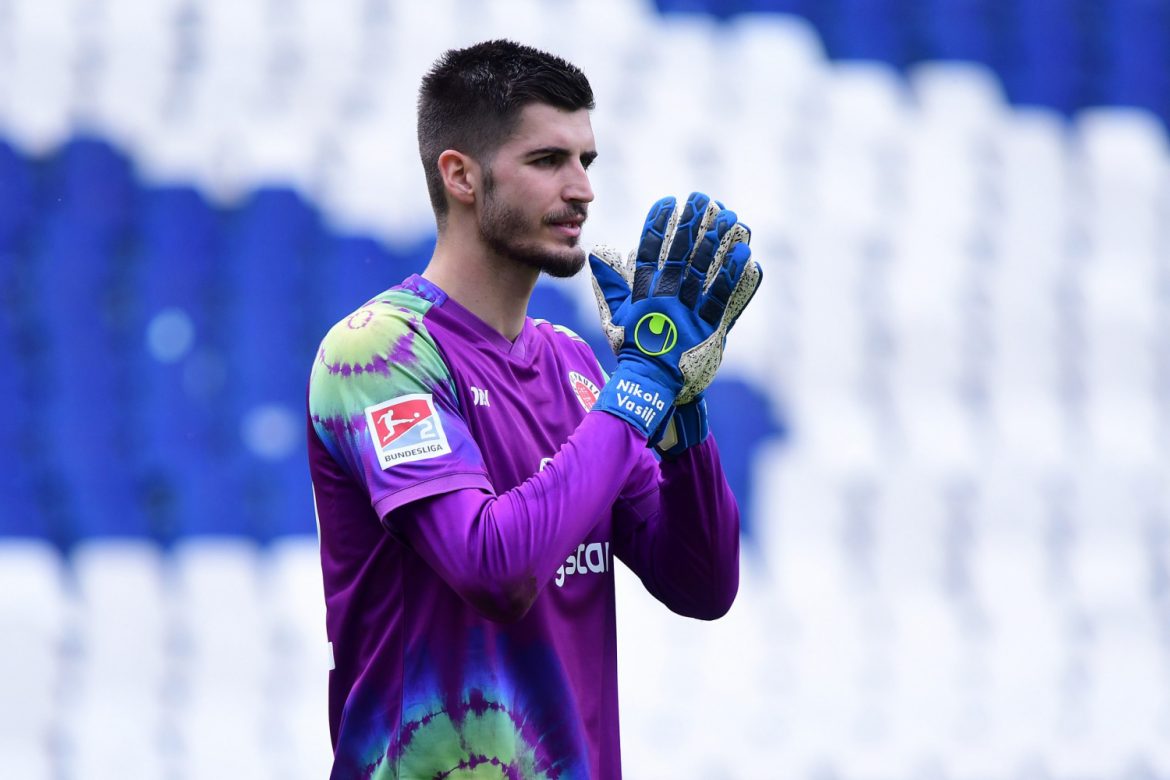

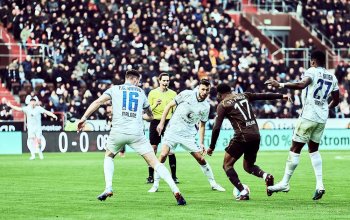
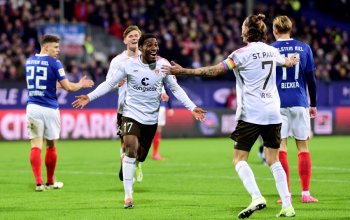
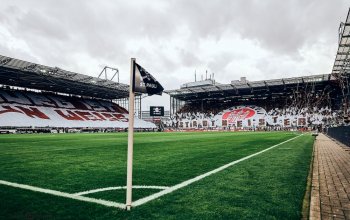
Passend zum 2. Frühstück! Danke!
Guten Appetit!